Spirit Airlines Bundle
How Does Spirit Airlines Take Flight?
Spirit Airlines, a prominent Spirit Airlines SWOT Analysis, has revolutionized air travel with its ultra-low-cost carrier (ULCC) approach. But how does this airline, known for its budget-friendly fares, actually work? This deep dive explores the mechanics behind Spirit Airlines' operations and its unique Spirit Airlines business model.
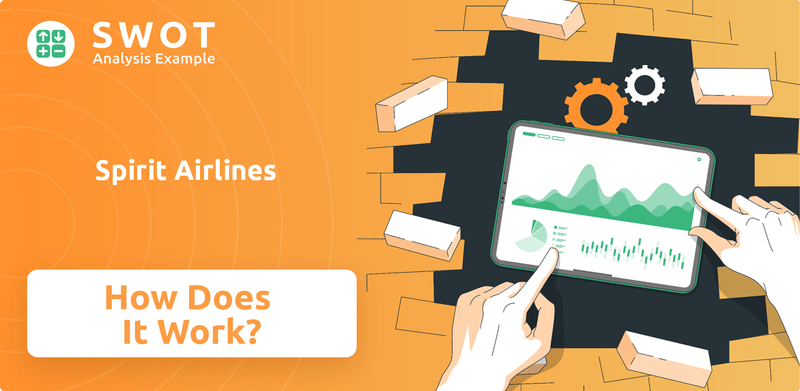
From understanding Spirit Airlines flights and Spirit Airlines fees to navigating its extensive network, this analysis provides a comprehensive look at the airline's strategy. Discover how Spirit Airlines carves its niche in the competitive aviation landscape and what challenges it faces. Uncover the secrets behind its sustained presence and its approach to customer service, including baggage fees and flight policies, to see if it's a good airline for you.
What Are the Key Operations Driving Spirit Airlines’s Success?
The core of the Spirit Airlines business model revolves around providing affordable air travel. This is achieved by offering a basic flight ticket at a low price, with all other services treated as optional extras. This ultra-low-cost carrier (ULCC) approach allows the airline to target budget-conscious travelers.
The value proposition of Spirit Airlines is centered on offering the lowest possible fares. Customers can customize their travel experience by selecting and paying only for the services they need, such as baggage, seat selection, and in-flight refreshments. This unbundling strategy enables Spirit to maintain lower base fares compared to traditional airlines, making air travel more accessible to a broader range of customers.
Spirit Airlines' operations are designed to support its ultra-low-cost model. The airline uses a standardized fleet of Airbus A320 family aircraft, which streamlines maintenance and pilot training. High aircraft utilization and quick turnaround times are crucial for maximizing revenue. Direct sales through its website and app reduce distribution costs. Additionally, customer service is streamlined, with an emphasis on self-service options. These operational efficiencies contribute to the airline's ability to offer low fares.
As of 2024, Spirit Airlines operates an all-Airbus A320 family fleet. The airline aims for high aircraft utilization rates to maximize revenue. In 2023, the airline reported an average of 11.3 hours of aircraft utilization per day.
Spirit Airlines generates revenue primarily from base fares and ancillary services. Ancillary revenue includes baggage fees, seat selection fees, and other add-ons. In 2023, ancillary revenue accounted for approximately 48% of the airline's total revenue.
Spirit Airlines focuses on aggressive cost management across all aspects of its operations. This includes fuel efficiency, labor costs, and airport fees. The airline's cost per available seat mile (CASM) is a key metric. Spirit aims to keep its CASM low compared to traditional airlines.
Spirit Airlines' customer experience is designed to support its low-fare model. This includes online check-in, self-service options, and a la carte services. The airline's customer satisfaction scores are often lower than those of traditional airlines, reflecting its focus on cost over amenities.
Spirit Airlines' success hinges on several key strategies that support its ultra-low-cost business model. These strategies include fleet standardization, high aircraft utilization, and a focus on ancillary revenue.
- Fleet Standardization: Using a single aircraft family (Airbus A320) simplifies maintenance, training, and parts inventory.
- High Aircraft Utilization: Keeping aircraft in the air for as many hours as possible maximizes revenue generation.
- Ancillary Revenue: Charging fees for services beyond the base fare helps to offset low ticket prices.
- Direct Sales: Selling tickets primarily through its website and app reduces distribution costs.
Spirit Airlines SWOT Analysis
- Complete SWOT Breakdown
- Fully Customizable
- Editable in Excel & Word
- Professional Formatting
- Investor-Ready Format
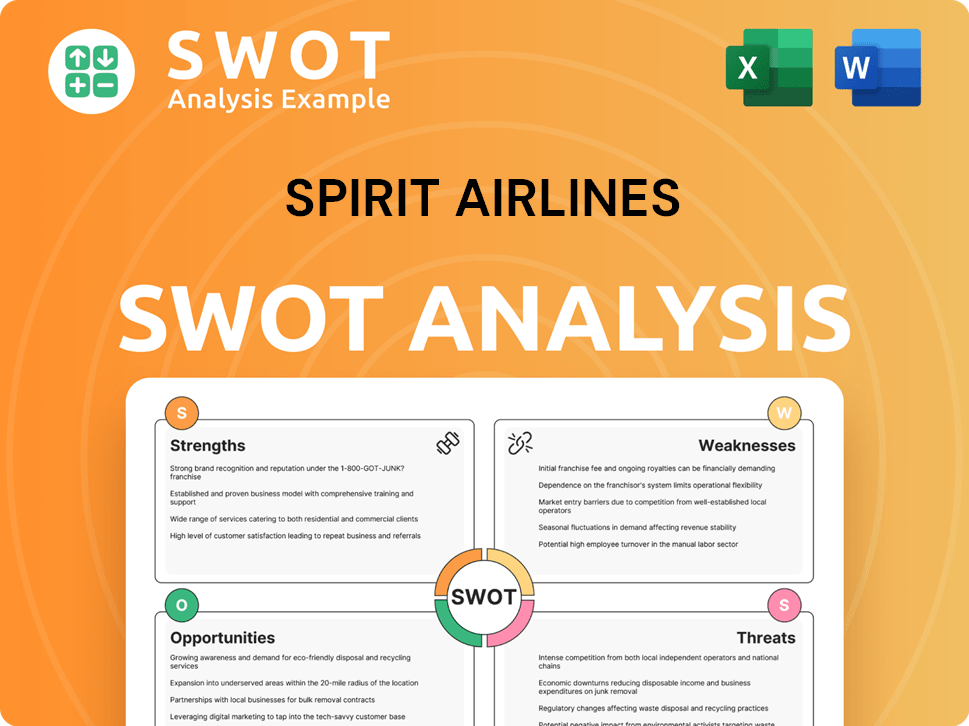
How Does Spirit Airlines Make Money?
The revenue streams and monetization strategies of Spirit Airlines are designed to maximize profitability within the ultra-low-cost carrier (ULCC) model. Spirit Airlines generates revenue through a combination of base fares and ancillary services. This approach allows the airline to offer extremely low base fares, attracting price-sensitive customers, and then monetize additional services and features.
Spirit Airlines' business model focuses on unbundling services, which means that the base fare covers only the transportation of a passenger from point A to point B. Additional services, such as baggage, seat selection, and in-flight refreshments, are available for an extra fee. This strategy allows Spirit Airlines to offer competitive base fares while also generating significant revenue from these add-ons.
Spirit Airlines continuously evaluates and refines its ancillary offerings and pricing to optimize revenue generation. By strategically pricing and offering a variety of services, Spirit Airlines aims to maintain competitive base fares while significantly boosting its overall revenue per passenger. This approach is a key component of Spirit Airlines operations and financial success.
Spirit Airlines has two primary revenue streams: passenger ticket sales and non-ticket revenue, also known as ancillary revenue. The airline's strategy is to keep base fares low and generate additional income through various fees. This is a core element of the Spirit Airlines business model.
- Passenger Ticket Sales: This is the base fare for air travel, representing the core revenue from transporting passengers.
- Ancillary Revenue: This includes fees for checked bags, carry-on bags, seat selection, flight changes, and in-flight purchases. It's a critical component of Spirit Airlines operations.
Ancillary revenue is a significant driver of Spirit Airlines' profitability. The airline generates this revenue through a variety of fees and services, allowing it to offer lower base fares. Understanding the specifics of Spirit Airlines fees is crucial for passengers. For more insights into the airline's growth strategy, consider reading about the Growth Strategy of Spirit Airlines.
- Baggage Fees: Fees are charged for checked bags and carry-on bags that exceed personal item size restrictions.
- Seat Selection Fees: Passengers pay extra to choose specific seats, including those with extra legroom or exit row seats.
- Change and Cancellation Fees: Fees apply if passengers need to change or cancel their flights.
- Online Booking Fees: Fees may be charged for booking flights online.
- In-Flight Sales: Revenue is generated from the sale of snacks, beverages, and other items during flights.
Spirit Airlines PESTLE Analysis
- Covers All 6 PESTLE Categories
- No Research Needed – Save Hours of Work
- Built by Experts, Trusted by Consultants
- Instant Download, Ready to Use
- 100% Editable, Fully Customizable
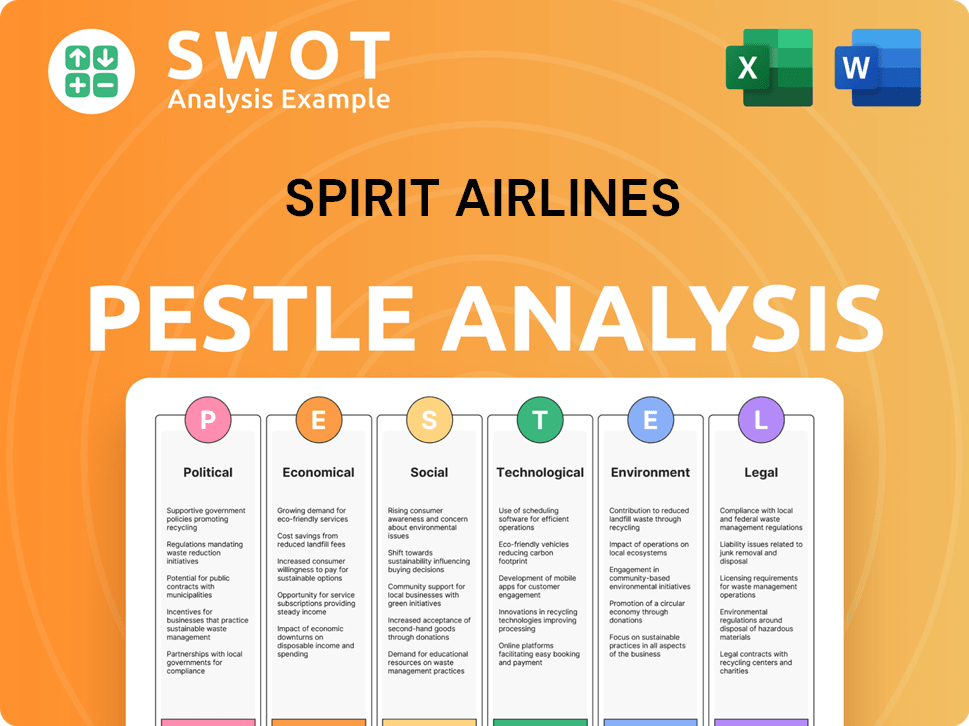
Which Strategic Decisions Have Shaped Spirit Airlines’s Business Model?
The journey of Spirit Airlines has been marked by pivotal moments and strategic shifts that have shaped its operations and financial performance. A key strategic move was the full embrace of the ultra-low-cost carrier (ULCC) model in the early 2000s. This involved unbundling fares and aggressively charging for ancillary services, a move that helped Spirit Airlines differentiate itself and attract price-sensitive travelers.
More recently, the proposed merger with JetBlue, announced in July 2022, was a significant strategic effort to create a larger, more competitive airline. However, this merger was blocked by a federal judge in January 2024, due to concerns about reduced competition and higher fares. This highlighted the regulatory hurdles and market scrutiny faced by major consolidation attempts in the airline industry. For a deeper dive into the company's beginnings, you can read a brief history of Spirit Airlines.
Spirit Airlines' competitive advantage stems primarily from its cost structure and its brand positioning as the 'low-fare leader.' Its efficient operations, including a standardized fleet and high aircraft utilization, enable it to maintain lower operating costs compared to legacy carriers. The strong brand recognition as a budget-friendly option also contributes to its competitive edge, attracting a loyal customer base focused on affordability.
Spirit Airlines fully embraced the ULCC model in the early 2000s, unbundling fares and charging for extras. The proposed merger with JetBlue, announced in July 2022, was blocked in January 2024 due to antitrust concerns. These moves significantly impacted Spirit Airlines' strategic direction and market position.
The ULCC model allowed Spirit Airlines to offer lower base fares, attracting price-sensitive travelers. Efforts to merge with JetBlue aimed to expand market share and enhance competitiveness. Despite the merger's failure, Spirit Airlines continues to adapt to market changes.
Spirit Airlines maintains a cost advantage through efficient operations and a standardized fleet. Its strong brand recognition as a low-fare option attracts a loyal customer base. Despite challenges, Spirit Airlines focuses on operational efficiencies to maintain its cost advantage.
Spirit Airlines has been focusing on optimizing its route network and enhancing ancillary offerings. The company is also emphasizing operational efficiencies to maintain its cost advantage. These efforts are aimed at adapting to new trends and competitive pressures.
Spirit Airlines focuses on high aircraft utilization to reduce costs. Ancillary revenue is a significant part of Spirit Airlines' revenue model, contributing substantially to overall financial performance. The airline continuously reviews and adjusts its route network to optimize profitability.
- Spirit Airlines operates a fleet of Airbus A320 family aircraft.
- The company emphasizes high seat density to maximize passenger capacity.
- Spirit Airlines offers a variety of ancillary services, including baggage fees, seat selection, and onboard refreshments.
- Spirit Airlines has faced challenges related to customer service and on-time performance.
Spirit Airlines Business Model Canvas
- Complete 9-Block Business Model Canvas
- Effortlessly Communicate Your Business Strategy
- Investor-Ready BMC Format
- 100% Editable and Customizable
- Clear and Structured Layout
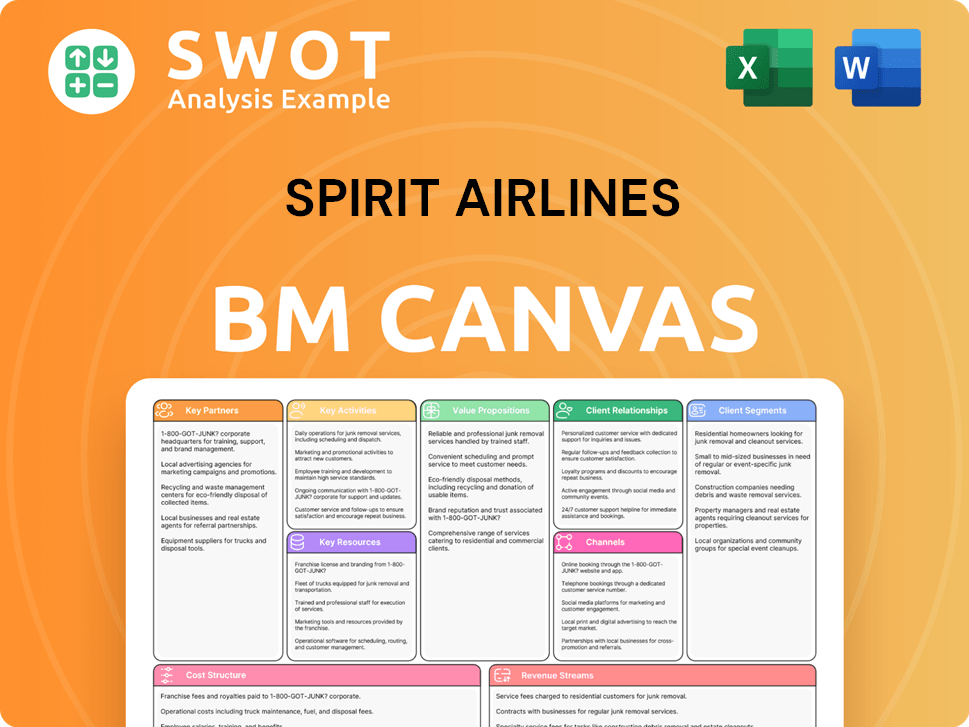
How Is Spirit Airlines Positioning Itself for Continued Success?
Spirit Airlines operates as an ultra-low-cost carrier (ULCC), distinguishing itself through its focus on offering exceptionally low base fares. This strategy positions it competitively against other ULCCs such as Frontier Airlines and Allegiant Air, as well as against legacy carriers on price-sensitive routes. The Marketing Strategy of Spirit Airlines highlights the airline's approach to attracting budget-conscious travelers.
The company's success relies on its ability to generate significant ancillary revenue through fees for services like baggage, seat selection, and other add-ons. Spirit Airlines flights and operations are structured to maximize efficiency and minimize costs, enabling it to offer low fares. However, this business model is susceptible to various risks, including fluctuating fuel prices, economic downturns, and intense competition.
Spirit Airlines holds a significant position in the North American airline market. It focuses on the ultra-low-cost carrier model, competing directly with other ULCCs. Spirit Airlines destinations and routes span across the United States, Latin America, and the Caribbean.
The airline faces risks from regulatory changes and intense competition. Economic downturns and shifts in consumer preferences also pose challenges. Operational issues like pilot shortages and air traffic control limitations can impact flight schedules.
Spirit Airlines is likely to focus on optimizing its network and exploring underserved markets. The company aims to maintain its cost leadership while adapting to market changes. It will continue to refine its ancillary revenue strategies.
Spirit Airlines aims to sustain and expand its profitability by offering competitive base fares. The company focuses on maximizing revenue from optional services. It adapts to market dynamics and maintains its cost leadership.
In recent financial reports, Spirit Airlines has shown a focus on improving its operational efficiency and profitability. The airline's strategy involves managing costs and optimizing revenue streams. Understanding the Spirit Airlines business model is key to evaluating its financial performance.
- 2024: Spirit Airlines reported a load factor of around 80% in recent quarters, indicating strong demand for its flights.
- 2024: The airline's ancillary revenue per passenger has been a key metric, with efforts to increase this through various add-on services.
- 2024: Spirit Airlines has been focusing on improving its on-time performance, which is crucial for customer satisfaction and operational efficiency.
- 2024: The company continues to evaluate its fleet and route network to optimize profitability and adapt to market changes.
Spirit Airlines Porter's Five Forces Analysis
- Covers All 5 Competitive Forces in Detail
- Structured for Consultants, Students, and Founders
- 100% Editable in Microsoft Word & Excel
- Instant Digital Download – Use Immediately
- Compatible with Mac & PC – Fully Unlocked
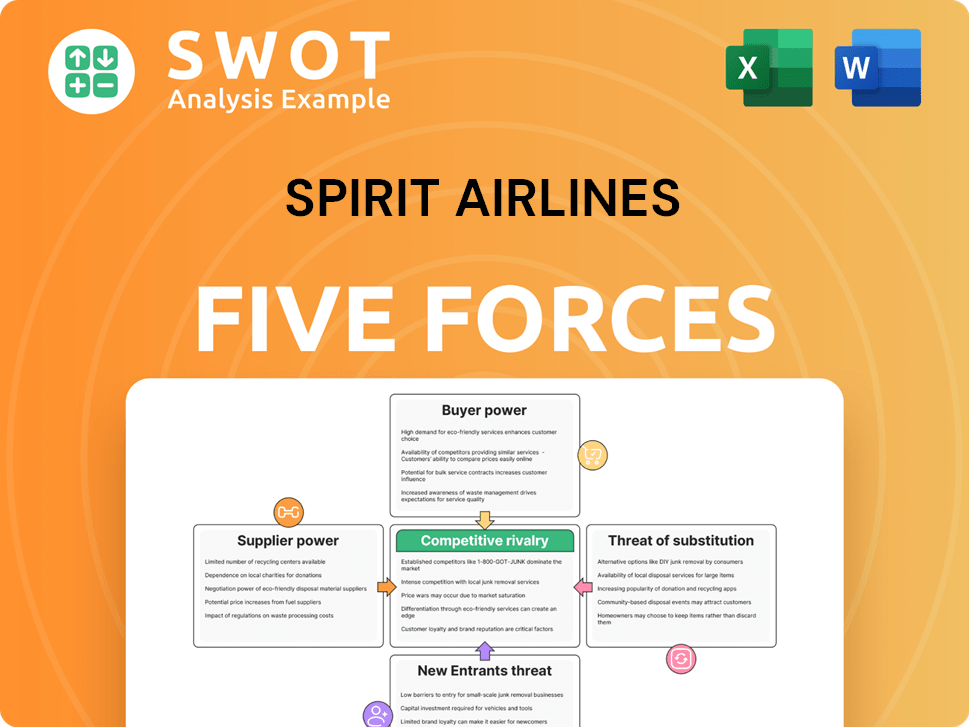
Related Blogs
- What are Mission Vision & Core Values of Spirit Airlines Company?
- What is Competitive Landscape of Spirit Airlines Company?
- What is Growth Strategy and Future Prospects of Spirit Airlines Company?
- What is Sales and Marketing Strategy of Spirit Airlines Company?
- What is Brief History of Spirit Airlines Company?
- Who Owns Spirit Airlines Company?
- What is Customer Demographics and Target Market of Spirit Airlines Company?
Disclaimer
All information, articles, and product details provided on this website are for general informational and educational purposes only. We do not claim any ownership over, nor do we intend to infringe upon, any trademarks, copyrights, logos, brand names, or other intellectual property mentioned or depicted on this site. Such intellectual property remains the property of its respective owners, and any references here are made solely for identification or informational purposes, without implying any affiliation, endorsement, or partnership.
We make no representations or warranties, express or implied, regarding the accuracy, completeness, or suitability of any content or products presented. Nothing on this website should be construed as legal, tax, investment, financial, medical, or other professional advice. In addition, no part of this site—including articles or product references—constitutes a solicitation, recommendation, endorsement, advertisement, or offer to buy or sell any securities, franchises, or other financial instruments, particularly in jurisdictions where such activity would be unlawful.
All content is of a general nature and may not address the specific circumstances of any individual or entity. It is not a substitute for professional advice or services. Any actions you take based on the information provided here are strictly at your own risk. You accept full responsibility for any decisions or outcomes arising from your use of this website and agree to release us from any liability in connection with your use of, or reliance upon, the content or products found herein.